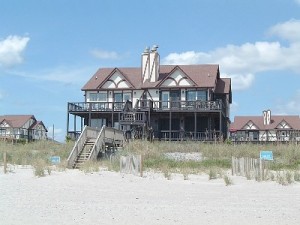submitted by jwithrow.
Journal of a Wayward Philosopher
Economics in One Lesson
June 29, 2015
Hot Springs, VA
The S&P closed out Friday at $2,101. Gold closed at $1,175 per ounce. Oil checked out at $60 per barrel. The 10-year Treasury rate closed at 2.48%, and bitcoin is trading around $246 per BTC.
Dear Journal,
We are back in the mountains of Virginia after our annual family gathering in Emerald Isle, NC. Last week, in addition to enjoying the beautiful Crystal Coast, I thought about the modern credit system that has been in place since 1971.
Speaking of last week’s journal entry, I felt a little clarification was in order after re-reading it myself. Lest the reader think otherwise, I am no Luddite and I have nothing against commercial development. I simply believe very strongly in the old capitalist principle that said commercial development should be fueled by actual capital that was formed from production and savings. Instead of capital, the modern credit system fuels commercial development with credit created ex nihilo. No one forewent present consumption to build said credit, and this dynamic creates distortions and malinvestment that accumulate over time.
The capitalist sees a private beach and wonders if commercial development would be a worthwhile endeavor. Does the market want three story luxury homes by the beach and cheap surf shops on the island? Will these projects be profitable? Will they attract additional capital to the area? To the capitalist, the focus is on individual human action. Private capital is then heavily deployed if commercial development is pursued.
The modern credit system, on the other hand, sees a private beach and declares that it needs to be developed. It is “third-world” to have beaches without luxury homes, says the credit system. What this place needs is more nail salons and ice cream parlors also, the credit system proclaims. Then the credit system does the math: ‘X’ luxury homes will bring ‘Y’ revenue in per week which will attract ‘Z’ additional people each summer… add together and subtract debt service costs… the number is positive – it’s a go! Then the bank pours out easy credit at low interest rates to get the project started. The focus is on “what should be” rather than human action in the marketplace.
Sure this is a black and white oversimplification and there are always shades of gray but the prevailing attitude remains the same.
The modern credit system emerged as modern economists grew arrogant enough to think they knew “what should be” in the economy. They started to see the economy as a system of pulleys and levers to be controlled and manipulated for maximum results so they began to formulate models. These models said the economy needed more aggregate demand which could be generated with more money, more credit, and more government spending.
It sounded easy enough but the economists ran into a tiny little problem at first: gold said “nope”. Instead of going along with their schemes, gold sat in a vault anchoring (too loosely) the money supply. The economists called him names like “grandpa” and “fuddy-duddy” but he had been accustomed to such scorn ever since the World Wars so gold didn’t budge. The economists would have to build their funny money utopia somewhere else. That is until President Johnson and President Nixon teamed up to finally cut gold out of the picture entirely. Thenceforth the modern credit system emerged and the economists were free to bark out orders and collect their enormous salaries as they were elevated to prominent positions in government and academia.
What’s been forgotten in this era of Keynesian economics is a simple economic principle that the classical economists knew all too well. Henry Hazlitt pointed this principle out way back in 1946 in Economics in One Lesson. Here’s Hazlitt:
“The art of economics consists in looking not merely at the immediate but at the longer effects of any act or policy; it consists in tracing the consequences of that policy not merely for one group but for all groups.”
You see, the classical economists weren’t much on forecasting. They didn’t have any models nor were they under the illusion that they knew what was best for economies of scale consisting of millions of unique individuals. They were mostly observers content to analyze what they saw and formulate economic principles accordingly. Without any aspirations for lofty positions in government or academia, the classical economists gained a sound body of understanding over time. This honest economic tradition has been built upon and carried forward by the Austrian School of Economics.
The Austrian School is hated by the Keynesians in government and academia because of their penchant for truth-telling thus you won’t often find the Austrian School on CNBC or in many college classrooms. The Austrians, however, were the only economists sounding the alarm well before the crisis of 2008 hit. They saw the housing bubble forming as the Fed cut interest rates and promoted easy credit in response to the bursting of the tech bubble. They could clearly see that Fannie Mae (FNMA) and Freddie Mac (FHLMC) were insolvent. They knew the mass-securitization and propagation of complex derivatives taking place on Wall Street was rapidly increasing fragility within the financial system.
A few Austrians were even invited to share their warning on CNBC prior to the 2008 crisis and they were ridiculed and jeered for their efforts. No one cared to look at the long-term effects of the Fed’s policies because the housing market was booming and everyone was living large. They just didn’t understand that the boom was artificially stimulated by funny money and easy credit thus doomed to end in a major bust. It all comes back to our ‘economics in one lesson’ principle as espoused by Hazlitt above.
Coming full circle: commercial development fueled by artificially low interest rates and credit created from thin air always leads to a short-term boom that is unsustainable. The credit entering the local economy pushes up real estate prices and the cost of living in general. Most of this easy credit finds its way into the finance, insurance, and real estate sectors which is why those industries have grown tremendously.
Here’s the thing: the commercial development that has occurred in places like Emerald Isle, NC would likely happen in a free market economy with sound money and honest interest rates as well. It might just take a little longer to come to fruition because significant private capital would have to be pooled first. The upside would be a stable economy without wild booms and busts. Money would actually maintain its purchasing power over time thus the cost of living would not constantly increase. The middle class would likely grow rather than contract.
However, such a system would severely limit governments, academia, Wall Street, special interests, and the Keynesian economists who have provided intellectual cover for this madness. There could not be an $18 trillion national debt in a free market system. There could not be military bases all over the globe and perpetual war. There could not be mass surveillance and a massive militarized police force. There could not be cradle-to-grave social welfare programs. There could not be corporate welfare programs such as those enabled by the mercantilist Export-Import Bank. There could not be government home loan or student loan guarantees to prop up the housing and higher-ed markets. There could not be government grants of all shapes and colors. A large swath of government employees and government contractors would have to find gainful employment in the free market. Individuals, communities, and associations would actually have to take responsibility for their own well-being.
Who could possibly be in favor of such a radical idea?
More to come,
Joe Withrow
Wayward Philosopher
For more of Joe’s thoughts on the “Great Reset” and the fallacy of central planning please read “The Individual is Rising: 2nd edition” which will be available later this year. Please sign up for the notifications mailing list at http://www.theindividualisrising.com/.

